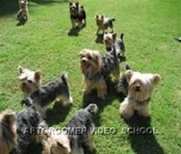 |
Golden Retriever
Other Names: Goldens Country of origin: Great Britain Dog Group Kennel Club: Gundog General appearance: Although Golden Retrivers are easily recognisable by their golden colour, they have medium length outer coats with water resisting under coats. The outer coat is firm, resilient, and can be wavy or straight. The tail and legs are feathered with longer hair. The Golden Retriever has a friendly and intelligent expression with perfect symmetry and superb, flowing movement covering the ground with long, powerful strides.The under coat is dense and soft in texture. They are medium in size and have an athletic look. The head is broad and arched with a well-defined stop. The ears should neither be small nor large and set on at the approximate level of the eyes. The neck is long, clean and muscular, and merges into well-laid-back shoulders. The body should be well-balanced and short-coupled with deep well-sprung ribs and a level topline. Colours: Golden, from very pale to dark. Size: Bitch 51cm - 56cm Weight: Min Max Temperament: Golden Retrievers are fun, active, patient and affectionate. They are gentle, love play and enjoy water. Golden Retrievers are loveable, polite, and highly intelligent. They do not do well if left alone for extended periods of time or they will become mischievous and destructive. They are friendly with other pets. In fact, they are friendly with everyone. They tend to bark as a form of greeting. The Golden Retriever is not well suited for a two career family as they require an inordinate amount of human interaction and companionship. They adore children and love to be involved in all family matters, whether indoors or outdoors. They are foremost a retriever and are therefore very orally fixated. Goldens will attempt to drag, pull or carry anything they can fit into their mouths. Movement: Long reaching to cover ground effortlessly. Care and training: The Golden Retriever requires daily and thorough brushing with a firm bristle brush. They should be dry shampooed regularly, and bathed only when absolutely necessary with a mild shampoo. Goldens are extremely intelligent dogs with an intense desire to please. Therefore they make superb candidates for fieldwork, showing, obedience, companionship and assistance for the disabled. Overall Exercise: 80 - 100 minutes per day. Feeding requirements: The Golden is one of the easiest dogs to feed, being neither fussy nor prone to stomach upsets. However, they are a greedy breed and care must be given to ensure owners guard against excessive feeding in an effort to keep the dogs lean and healthy. Exercise: Med Grooming: Med Noise: Low Personal Protection: Low Suitability As Guard Dog: Low Level of Aggression: Low Compatibility With Other Animals: High Suitablity for Children: High Often docked? No Average litter size: 6 - 10 Life expectancy (yrs): 10 - 15 Health issues: Due to the popularity of the breed, some have been inbred and have increased the risk of inherited diseases such as skin diseases, cancer, ectropion (extroverted eyelids), entropion (inverted eyelids), and heart disease. History: The story of the Golden Retriever is found in the recorded accounts of a man named Sir Dudley Majoribanks (later known as Lord Tweedmouth) in England. Rumors of the Golden's history said that Majoribanks (or Tweedmouth) happened to see a troupe of eight Russian sheepdogs performing in a circus in the seaside resort of Brighton, England. They say he was so impressed that following the show he offered to buy two of them, to which the owner denied this offer, saying that it would ruin the show if not all eight were present. To this Tweedmouth offered to purchase all eight dogs. The Golden Retriever's history is documented by handwritten records of Lord Tweedmouth. This rumor was circulated widely around the time the Golden Retriever came about, but all of Majoribanks' records do not indicate such an occurrence. He being the person who is credited with developing the breed, this rumor is likely not true. Lord Tweedmouth took a liking to the yellowish golden color and decided to expand on it. He bought a dog named "Nous" who was a Flat Coated breed. In 1868, Lord Tweedmouth mated a Tweed Water Spaniel (an extinct breed today that had a curly coat of light liver color) named "Belle" to Nous, and this resulted in the foundation of the definitive yellow breed now known as the Golden Retriever. Over the next 20 years he introduced more breeds into the mix, including the Labrador, Red Setter, and possibly a Bloodhound. In 1881 Lord Tweedmouth's son took two yellow retrievers with them to their family's Texas ranch. The name of the breed morphed several times. The breed was first exhibited under the name of Russian Retriever or Russian Retriever and Tracker, due to the story of the Russian performing troupe. In 1913 they were first shown as Golden Flat Coats, then they were called by the name of Golden or Yellow Retriever. In the 1920s, finally, the breed acquired its current name. Today the Golden Retriever is bred in certain lines for specific reasons: there is a line bred for retrieving and field trials, a line for performing in shows and for family, as well as a line produced specifically for guiding the blind. The Golden Retriever is one of the most popular dogs of today, more popular in American than in its native country.
|
|
|
|
